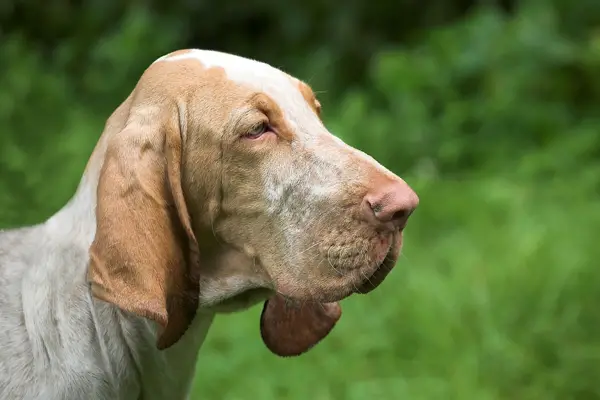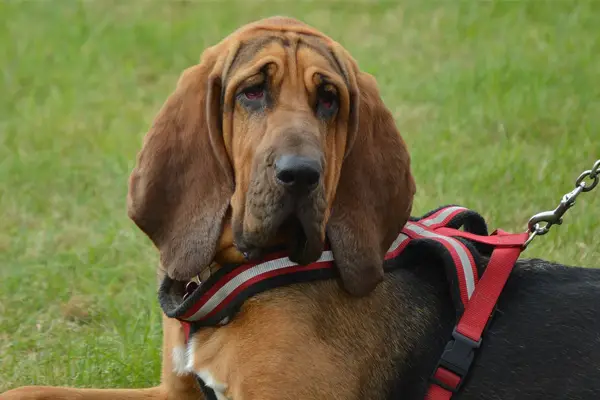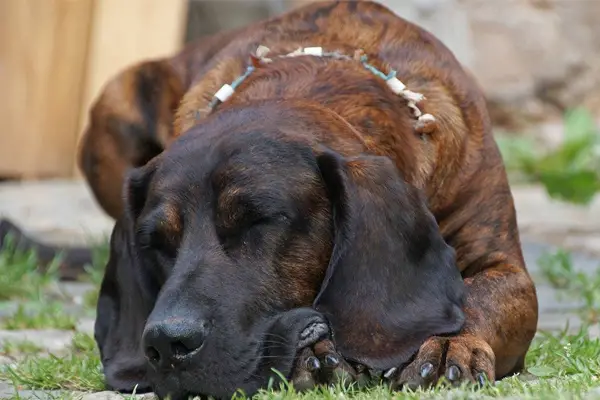Bloodhounds are large-sized dogs that stand at the height of 23 to 27 inches and can weigh up to 110 pounds. The Bloodhound features a wrinkled face, loose skin, and long droopy ears. They also have deep-set eyes that have a hint of sadness. But, even if they look sad, Bloodhounds are affectionate dogs.
They are known to enjoy human company, even with other kids and dogs. They are also very gentle, but his energy can be boundless. They are the best companions for those who love adventures. But, you would have to make sure you get their nose in control. With their keen sense of smell, you really wouldn’t know where it can take them.

Bloodhound Statistics
| Dog Breed Group | Hound |
| Breed Size | Giant |
| Height | 25-27 inches (male); 23-25 inches (female) |
| Weight | 90-110 pounds (male); 80-100 pounds (female) |
| Lifespan | 10-12 years |
Bloodhound Ratings
| Energy level | |
| Exercise needs | |
| Requires attention | |
| Playfulness | |
| Trainability | |
| Shedding | |
| Grooming | |
| Friendly with family | |
| Friendly with kids | |
| Friendly with strangers | |
| Friendly with other dogs | |
| Prey Drive |
Bloodhound History
The Bloodhound’s origin is still unclear. However, many historians believed that it had been around since the ancient Mediterranean. They were first mentioned in a third-century book by a scholar Aelian. And as it appears, it seems that the Bloodhounds have been the oldest extant hound that hunts by scent.
The Bloodhounds were known to have been perfected in the 7th century. Thanks to St. Hubert of Belgium and his monks who were responsible for the breeding. St. Hubert, while he was alive, dedicated his life’s work to breeding these capable working dogs. And even after his death, the dog breed flourished.
Bloodhounds have a long history with a trace of royalty. Even William the Conqueror brought several bloodhounds with him when he came to England in 1066. And Elizabeth I kept her pack of the dog breed as well.
But as years passed and with the coming of the French Revolution, Bloodhounds were no longer of great use. But, they were still treasured in England as excellent trackers. According to records, they have been tracking criminals since 1805.
When the Victorian-era came, Bloodhounds’ popularity was also boosted. They joined in dog shows, they became excellent companions, and people loved their exotic beauty. Even Queen Victoria loved the dog breed and had one of her Bloodhounds participate in a dog show.
It was in England where the modern Bloodhounds we know today originated. And it even made its way to America in colonial times.
Now, they are one of the best man-trailers who primarily help agencies in search and rescue work. Their sense of smell is so strong that it is even used as reliable evidence in the American Court.

Bloodhound Temperament
Bloodhounds are not vicious beasts, even if it was how Harriet Beecher Stowe depicted them in her novel. As a matter of fact, they are gentle, patient, and good-natured dogs. The American Kennel Club even describes them as friendly and independent dogs.
They make great family pets, and they are especially good at handling children. With his patience, he wouldn’t mind the toys all over him. He is even friendly with other animals or dogs too.
But, never mistake them as a lazy dog.
Bloodhounds have boundless energy, and they require plenty of space and safe areas to run around. They also need a lot of exercise, and if you’re taking him for a walk outside a fenced yard, having a leash is very important.
With their incredible sense of smell, he might wander off far. So, you always need to keep an eye on them or create great security so they won’t get lost.
They need training, and they need someone firm and consistent with doing this effectively. Bloodhounds tend not to obey his owner’s commands, so make sure to bring along great patience.
Don’t be harsh to Bloodhounds. They are a sensitive breed, and mistreating them will not help build the right temperaments for them.
Bloodhound Care Requirements
- Nutrition: Bloodhounds, just like any other dogs, need a high-quality, balanced diet that will help provide them energy. The main part of their diet should be protein to help build those muscles, and you should only get these from high-quality meat, poultry, or fish. Then, add some fats and carbohydrates to their diet to support its healthy coat and provide energy. You can get fats from fish or vegetable oils, and carbohydrates from whole grains. You can also add fruits and vegetables as sources of fiber. The balance between these nutrients should depend on your Bloodhounds age. A puppy Bloodhound might require a minimum of 22% of protein and 8% of fat, and as it grows older, this will minimize. Another thing to keep in mind is the amount you’re feeding him. Watch for that calorie-intake, because even if they’re a large dog breed, you still don’t want to get them overweight. An overweight dog is more prone to diseases, and you don’t want this for your dog. If you are not sure how much to feed them, you can ask your vet for a guide. For commercial food products, stay away from products that have plant-based protein as ingredients. It should not also contain fillers, artificial flavoring, and by-products.
- Grooming: Bloodhounds have short coats that shed seasonally, about once or twice a year. To lessen loose hair problems, it’s best to do some weekly brushing even if it’s not shedding season. And if it is, daily brushing is highly recommended. You should give them a regular bath as they can be prone to doggy odor. Just make sure to use the right kind of dog shampoo, which won’t damage his skin. Also, make sure to clean those creases on his face well so dirt won’t accumulate. You can wipe this with a towel daily to keep it clean and prevent infection. Nails should be trimmed regularly because long nails are painful for a dog, especially for a Bloodhound who wants to do a lot of activities.Exercise: If you think that Bloodhounds are lazy dogs, then you’re wrong. This is a highly energetic dog breed that requires daily exercise. Long walks would be highly beneficial for him; however, always keep him on a leash. With his excellent sense of smell, he might catch something fascinating, and he will be hard to control (they are not the most obedient dogs). If you have a fenced yard, you can do some extra activities, such as playing fetch or making him track something. This is also an excellent way for both of you to bond. Just make sure to keep a close eye on him.Health: Bloodhounds are also prone to some health conditions. And usually, breeds of large sizes commonly experience gastrointestinal issues. This is why you should be mindful of what you feed him. Other than gastrointestinal issues, Bloodhounds are also prone to eye and skin problems such as ectropion, entropion, and dermatitis. Some health conditions you also need to watch out for are aortic stenosis, ear infections, hip and elbow dysplasia, epilepsy, and otitis externa. Some of these have screening tests available that your dog can take. This way, you can rule out some of them. If you also notice anything different from your pet, don’t think twice about visiting the vet for a check-up.
- Lifespan: The life expectancy of Bloodhounds is 10-12 years.

Famous Bloodhounds
- Pluto: Mickey’s dog
- Trusty: Disney Bloodhound from the Lady and the Tramp film
- Ladybird: The Bloodhound from the film King of the Hill
- Duke: The Bloodhound character from the show the Beverly Hillbillies
Fun Facts About Bloodhounds
- They originated in Belgium in the 7th century.
- The name Bloodhound came from the fact that breeders recorded every detail of the dog’s ancestry to preserve its purity.
- They are sometimes referred to as “a nose with a dog attached” because of their profound sense of smell. They have approximately 250-300 million scent receptors.
- Bloodhounds are reliable sources of evidence; the US Court of Law acknowledges any evidence found with their help.
Check Out Other Hound Dog Breeds:
Afghan Hound, American English Coonhounds, American Foxhound, Basenjis, Basset Hound, Beagle, Black and Tan Coonhound, Bluetick Coonhound, Borzois, Cirnechi dell’Etna, Dachshund, English Foxhound, Grand Basset Griffon Vendeens, Greyhound, Harrier, Ibizan Hound, Icelandic Sheepdogs, Irish Wolfhound, Norwegian Elkhound, Otterhound, Petit Basset Griffon Vendéen, Pharaoh Hounds, Plotts, Portuguese Podengo, Redbone Coonhound, Rhodesian Ridgeback, Salukis, Scottish Deerhounds, Sloughis, Treeing Walker Coonhound, Whippet
